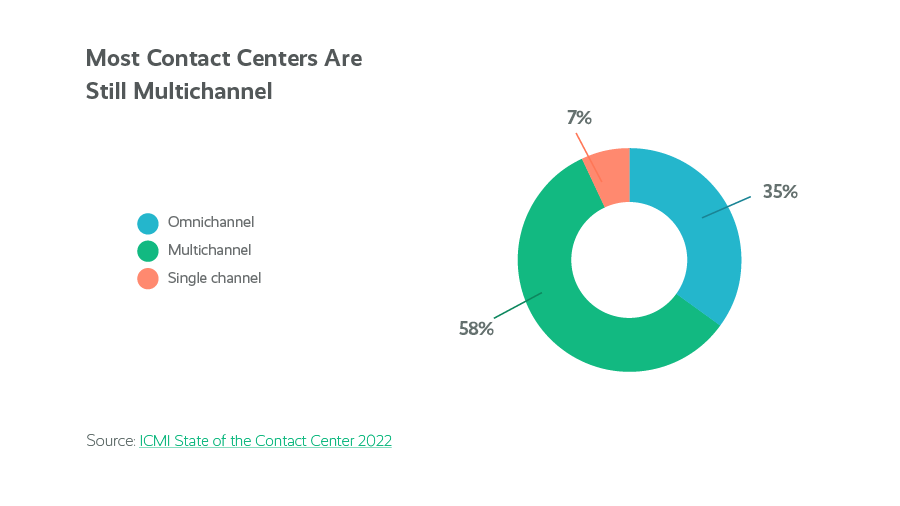Why A Digital Contact Center Is Essential for Meeting Today’s Customer Expectations
When I lived in Colombia, it seemed as if there were fruit stands on every corner. Some fruit sellers would even balance bags of fruit on sticks, running between cars to hawk their harvest. Piña (pineapple)! Tomate de árbol (tree tomato)! And my favorite, maracuya (passionfruit)!
There were so many choices, but I always went back to the same stand. Why? It’s simple: fantastic customer service. My interactions with the fruit seller were authentic and friendly, and he answered all my questions. He always remembered me, even if he never knew my name.
It’s no secret that stellar customer service is the first step to customer loyalty, but you’re not dealing with a couple of people meandering through a fruit store. Customers today have higher expectations than ever before.
Unlike my favorite fruit seller, you’ve got hundreds or thousands (or hundreds of thousands) of customer issues that require sophisticated, efficient customer care through the right contact center solutions. So what, exactly, do customers expect and how can you provide them with the exceptional digital customer experience they deserve?

What Is A Digital Contact Center?
Before digging into our customers’ expectations, let’s get some clarity on what it means to be a digital contact center.
The simple, straightforward definition of a digital contact center is “a customer service center that provides support through email, chat, text messages, social media, phone, and other communication channels.” However, the positive benefits of this seemingly simple definition go much deeper. A digital contact center must take an omnichannel approach to customer interactions to make communication more convenient for the customer and boost the agent experience at the same time.
Related Article: The Top 4 Contact Center Trends To Boost Performance And CX
What Is An Omnichannel Contact Center?
Is your contact center omnichannel? The answer lies in whether your digital channels are connected.
A true omnichannel contact center integrates its engagement channels so that agents have full access to a customer’s history, no matter what channel they reach out in. Customers don’t have to repeat themselves because they can seamlessly move from one channel to the next. Multichannel contact centers offer service in many digital channels, but those channels are siloed.

Omnichannel cloud contact centers are known for speedy setup and low operating costs. When you’re integrating several digital channels, you need a good workforce management solution to lower handle times and provide more accurate forecasting data and capabilities across all channels.
Taking it a step further, you also need a solution that takes a digital-first approach to quality management. You also need one that empowers your workforce, harnessing the power of motivation and coaching for more agent productivity.
If you can do it all in a single platform, you’ll really knock the customer service experience out of the park. But I digress, let’s talk about the real stars of our show — the customers.
Related Article: How to Deliver An Outstanding Omnichannel Customer Experience
Customer Expectations In A Post-Pandemic World
The world is different than it used to be. Many people have even coined our pre-pandemic life “the before times,” as if we’re living out an apocalyptic sci-fi thriller. Not only do some of us jump if someone next to us sneezes or coughs now, but this McKinsey report states that the pandemic caused us to accelerate the production of digital products by about seven years.
Who demanded that acceleration? We, the customers, of course! Customer behaviors shifted rapidly. We surprised ourselves with our ability to rapidly shift into remote work environments, we moved our assets to the cloud, and the demand for online purchases and services skyrocketed.
As Forbes mentions in this example, “The pandemic led to record demand and revenue for Amazon (profits soared 220%), which helped us avoid shopping in person.” So what, exactly, would it take to meet (or even better exceed) customer expectations these days?
Let’s go through some key factors that make or break a great digital customer experience. Hint: They’re all unique to digital transformation.
Related eBook: Why Digital Matters: Connecting With Customers Beyond Voice

Data, Data, Data
I’m in love with my new smartwatch. Well, love is a strong word, but I really like it. My favorite part isn’t in the personalization of the watch face, or that I can listen to my tunes on my run without lugging around my clunky phone.
No, my favorite part is the health data my watch collects around my sleep patterns, my stress levels, and my activity level. It’s fascinating! But more than that, it’s starting to make a positive impact on my daily life. Maya Angelou is famous for her profound statement, “Do the best you can until you know better. Then when you know better, do better.”
While this statement undoubtedly helps us become better humans, it can also define how we think of our customer service. Digital contact centers leverage analytics just like my beloved watch, though the metrics change.
Instead of measuring steps, omnichannel digital contact centers can use metrics like Average Handle Time and contact volume — or quality management tools like agent evaluations and performance KPIs — to see what the customer experience is.
Once these metrics are known, businesses can more easily assess and address the root issues, empowering customers and employees by using digital technologies.
Omnichannel Support For Personalized Experience
Meeting your customers where they are is the heart of a strong customer relationship. While building out your customer service strategy and contact center operations based on your largest customer base is still considered a best practice, you’ll want to make sure everyone is included on the service spectrum.
According to McKinsey, more than half of customers use three to five channels when making a purchase or resolving an issue. What’s more, they absolutely expect a seamless, personalized experience rather than feeling like they’ve been “passed off” from agent to agent.
As a customer myself, I assume that any time I contact support they should already know who I am, what product I have, how many times I’ve contacted support before, and perhaps other key data on preferences or behavior. Don’t you feel the same?
Today’s customer does not have time to repeat their issue and will be quickly turned off by the inefficiency of precious wasted minutes. Multichannel support might keep your communication options open, but only omnichannel provides the end-to-end customer journey today’s customers expect.
Related Article: 5 Must-Haves for Growing Companies Looking to Create an Omnichannel Support Center

Help Yourself
Zendesk mentions that a whopping 86% of customers expect online self-service options. A robust self-service option for customers is the first line of defense to deflecting common requests. But if a customer does need more personalized attention for a specific issue, tickets can often be opened right from the website.
What’s more, once they click that “Contact Support” button, they still might be able to resolve their issue before tying up your contact center agents. Thanks to advances in AI and machine learning, chatbots can point customers to relevant articles before they ever open a ticket.
By the way, when customers help themselves, it doesn’t just ease the customer’s tension, but it also lightens the load of the hard-working humans on the other end of the figurative “line.” It’s a win-win.
Related Podcast: Talking to Machines: How AI Is Shaping the Future of CX
Digital Contact Center Solutions Do It Better
Thanks to concrete data collected through various studies mentioned throughout this article, we’ve learned a lot about our customers in the last two years. They are adaptable, resilient, and self-sufficient. They enjoy a wide range of communication channels and crave personalized attention.
You simply cannot expect to achieve much or any of this in your contact center if it is not an omnichannel contact center. Now that we know better, we can do better by choosing digital for our contact center operations. We owe that to our customers (and ourselves). Ready to get started? Playvox offers a comprehensive workforce engagement management solution to help your digital contact center measure what matters — and deliver a positive customer experience — at cloud speed.






